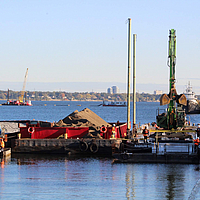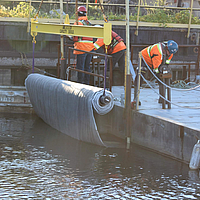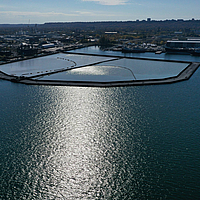Sediment Remediation
Project information
Active Capping at Randle Reef Site
Hamilton, Ontario, CA
Environment and Climate Change Canada
Public Services and Procurement Canada
Milestone Environmental Contracting Inc.
Summer 2020 to Fall 2020
Project details
The Randle Reef site is approximately 60 hectares located within Hamilton Harbour, which occupies the western tip of Lake Ontario. Randle Reef contains approximately 695,000 cubic meters of sediments contaminated with polycyclic aromatic hydrocarbons (PAHs) and heavy metals. Sources of the contaminants date back to the 1800s and were produced by coal gasification, petroleum refining, steel making, municipal waste, sewage and overland drainage. Over the years, contaminants have been migrating across the harbour floor and into the food chain of the local ecosystem. Environment and Climate Change Canada serves as the Project Lead and Public Services and Procurement Canada (PSPC) provides technical and project management, and procurement services for the undertaking of this project. Riggs Engineering was contracted by Canada to design a remediation plan that included constructing a 6.2 hectare Engineered Containment Facility (ECF) over the highly contaminated sediment, using a combination of hydraulic and mechanical dredging to remove approximately 445,000 m3and place within the ECF. This was followed by Isolation Capping of the Stelco Intake/Outfall Channel sediments and Thin Layer Capping of marginally contaminated sediment remaining. Arcadis and Anchor QEA were responsible for the technical design of the sediment cap. Milestone Environmental Contracting Inc. completed the Isolation Capping and Thin Layer Capping working in coordination with White Lake Dock & Dredge Inc.
Sediments located between the ECF and the Stelco property were first dredged, and then an engineered isolation cap was installed. In order to maintain the functionality of an industrial water intake and outfall area and also remediate the elevated contaminant levels, an active cap containing Tektoseal Active OC geocomposite was installed. The cap section consisted of 1 layer of Tektoseal Active OC, an approximate 700 mm thick sand mixture layer containing 3 % Total Organic Carbon, an upper geotextile, and a 200 mm thick layer of armouring stone. Approximately 1,270 m2 of Tektoseal Active OC were installed on the harbour floor. Each roll of geocomposite material was inserted onto a spreader bar that was connected to a long-armed material handler positioned on a barge within the channel. The opposite end of the geocomposite roll was attached to a second smaller barge by adding braces to the corners of the fabric and connecting them to secured anchor points to ensure accurate positioning (Photo 1). Combined with GPS positioning, this allowed for greater placement control and security of the material during installation. Once the geocomposite was properly positioned, a tug boat pulled the large barge in order to unroll the mat attached to the spreader bar, while the secondary barge remained stationary, securing the end of the mat (Photo 2). The Tektoseal Active OC rolls were overlapped 600 mm on the ends and 300 mm on the longitudinal edges for each consecutive roll. GPS positioning equipment was used to ensure accurate deployment of the rolls. The geocomposite was installed in water depths of 7 to 8 meters without the use of underwater divers. High concentrations of sediment contaminants and existing site features within the Stelco Channel were challenging obstacles for the design and installation of the active cap. HUESKER’s Tektoseal Active OC geocomposite was able toaddress these challenges by reducing the required cap thickness, while mitigating the risk of contaminant transport. The use of Tektoseal Active OC ensures a uniform layer of active material for contaminant sequestration, while Tektoseal Active OC’s upper and lower geotextiles protect against the loss of the organoclay from environmental forces and other transport mechanisms



